Hastings Irrigation Pipe Co. of Hastings, Nebraska, blazed a trail in the late 1940s by manufacturing irrigation pipe out of a relatively newly used material: aluminum. Five decades later, Hastings and that “new” material are both field-tested and proven commodities in the manufacture of irrigation and industrial piping.
Hastings recently retired two BWC-500 welding machines that welded aluminum in its tube mills since the 1970s. Hastings required replacement machines capable of 500-600 amps at 100 percent duty cycle. What it found instead were two brand new Dynasty® 700 TIG inverters from Miller Electric Mfg. Co. that met those goals and increased travel speeds, reduced tungsten costs and amperage draw, and reduced the amount of costly helium shielding gas used in the process. These efficiencies will allow Hastings to recoup new machine costs within one-and-a-half years of purchase, increase the rate of production and reduce overall welding costs.
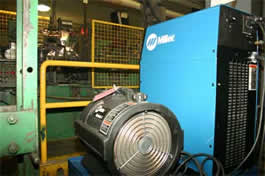 |
| The Dynasty 700 TIG inverter with Coolmate 4 Coolant System is easily placed near the tube mill, while operator Ray Garcia monitors the welding station. |
These benefits result from the Dynasty’s ability to control the arc in ways not possible with transformer-based machines: extending the balance control, adjusting output frequency and independently controlling current in each AC half cycle.
“With the new welders,” says Ken Shafer, superintendent, Hastings, “we can vary our frequency and get a more stable weld. It holds the tungsten better and you get a better start. There are definitely advantages to the new technology.”
Manipulating AC Wave Form Boosts Production Flow
Hastings’ Nebraska plant includes nine tube mills capable of forming and welding tubing from 2- to 12-in. in diameter at a variety of wall thicknesses (typically .051- to .083-in.). The specific piping discussed in this article and shown in the accompanying photos is .078-in., 3004-grade aluminum rolled into a 5-in. diameter.
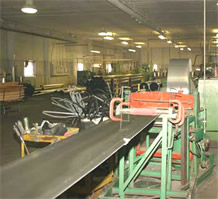 |
| From a coil of aluminum, a continuous sheet is trimmed, cleaned and fed through one of nine tube mills at Hastings Irrigation Pipe Co. |
The roll-forming process used to manufacture the piping involves taking a continuous strip of aluminum, trimming its edges to obtain the specified tube diameter, and rolling it until its edges meet and are welded together at a fixed weld station. A balled, ceriated or zirconium electrode melts the edges and fuses them together with 462 amps of non-stop welding power. No filler metal is used, and the weld puddle is protected by a mixture of argon (62 percent) and helium (38 percent) shielding gases.
The BWC-500s that Hastings relied upon to perform this weld became antiquated and less reliable as the years wore on. Shafer worked with Dennis Piel, distribution manager, Linweld, Inc., to find a solution that would replace the existing machines and improve productivity. Hastings tried a number of stop-gap machines until Piel presented them with the Dynasty 700 from Miller Electric.
 |
| The aluminum passes through a final forming roll and is rolled further using a Mandrel Bar, which provides support as the aluminum is ironed using pressure rolls. |
The first critical feature of the Dynasty 700 TIG inverter is the ability to fine-tune the electrode negative (EN) portion of the AC cycle from 30 to 99 percent (also known as balance control). A comparable feature was not available on the BWC-500s; and older, transformer-based machines with Squarewave™ technology only featured an EN range of the AC cycle from 45 to 68 percent. The Dynasty 700 provided the industry’s only combination of a wide EN range with 500 amps at 100 percent duty cycle. And unlike AC welding with conventional TIG machines where the output frequency is fixed at 60 hertz (Hz), the Dynasty 700’s output frequency can be adjusted from 20 to 400 Hz.
Hastings sets the EN portion of the AC cycle at 62 percent and the output frequency at 60 Hz. Increasing the EN portion of the cycle has provided distinct benefits in this application: increased travel speeds, a narrowed weld bead and a reduced etch zone for improved cosmetics.
“This has increased our travel speeds,” says Shafer. “We’re currently running around 21 feet per minute where it previously ran at 19 feet per minute (with the old machines).”
The Dynasty 700 also features independent AC amperage control that allows the operator to set the EN and electrode positive (EP) amperages independently. It allows the operator to direct more or less energy into the work piece as well as take heat off the tungsten. Independently increasing EN while maintaining or reducing EP permits the use of a smaller diameter tungsten to more precisely direct heat to the weld. The previous machine’s limitations forced the company to use a specialized electrode diameter (5/16-in.) that had to be specially ordered and cost more than off-the-shelf electrodes.
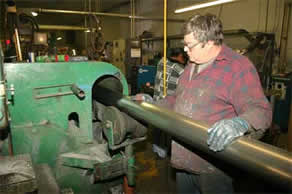 |
| Operator Dan Pohlmeier monitors the welded pipe and prepares it for finishing. |
“We were using 5/16-in. electrodes on this particular mill and now we’re down to 1/4-in.,” says Shafer. “We look at this in dollar figures. A 1/4-in electrode is a standard tungsten that I can get (off the shelf) and it costs me $26. The 5/16-in electrode was something special I had to order and it cost me $46.”
Not only is there a flat cost savings between the two electrodes, but the adjustment to the EN cycle allows for extended electrode life by taking heat off the electrode. Shafer reports that his mill workers typically redress the tungsten once each day, compared to several times per day with the old equipment.
Independently increasing EN amperage while maintaining or reducing EP amperage also allows the operator to reduce or eliminate costly helium in the argon/helium shielding gas mixture. Straight argon may suffice because this technology directs heat into the work and not the tungsten.
“We’ve dropped our cubic feet (helium/per hour) down,” says Shafer. “We’re probably running 15 cubic feet (helium/hour) right now where we used to run up to 20 or 25, but we have not eliminated it yet—we still use it to help with weld penetration.”
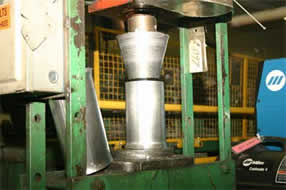 |
| This vertical press is used for expansion testing on a section of aluminum pipe. |
Paying Off Overhead
Integrating the new Dynasty 700 inverters into its tube mill application was simple: unplug the old BWC-500s and plug in the Dynasty (a 28-pin interface provides key automation controls and functions for “plug and play” system integration). The greatest change was running three-phase power to the tube mills instead of the single-phase power it ran off previously. Three-phase power ensures a constant flow of voltage to the inverter which helps the machine run smoothly and drastically decreases its amperage draw. Hooked into 240V three-phase power, the Dynasty 700 only pulls 67 amps at 100 percent duty cycle versus 142 amps with the old BWC-500s. Based on a mill running 2,000 hours per year, the savings are approximately $2,300 per year.
Additional savings have come in the form of Hastings’ water bill. By matching its Weldcraft WP27 welding torch with a Coolmate™ 4 water coolant system, Hastings has been able to recycle and conserve water instead of just cycling it through and dumping it down the drain. The Coolmate 4’s patented circular design and four-gallon tank provide a constant flow of coolant to keep the pump primed and to reduce algae buildup.
“Between the electrical and water savings,” says Shafer, “we expect payback on these machines in a year-and-a-half.”
Dynasty 700 Guarantees Consistency, Offers Flexibility
Hastings welds numerous thicknesses of aluminum at its Nebraska plant and has plans to purchase additional Dynasty 700s for its plant in Madera, California. With varying welding parameters and work at multiple sites, the potential to improperly weld a section of piping exists. This mistake results in costly scrap and rework. The Dynasty 700 has taken the guess work out of the process for Hastings by providing a program memory feature that stores four independent programs and includes “last procedure recall.” When switching to a different pipe product, the operator simply needs to pull the program up on the machine and start welding.
“It’s just human nature to tinker,” says Shafer. “These machines have a lot of switches. What’s good about these machines is that you can lock your programs in. We make sure to set the program how we want it and then lock it in, and that ensures quality and consistency.”
Shafer also appreciates the adjustable high frequency (HF) arc starting parameters featured on the Dynasty 700.
“These Dynasty’s fire right away,” says Shafer. “The second the arc is established, the HF shuts off. This Dynasty inverter switches [polarity] so quickly that we don’t need continuous HF to stabilize the arc, like we did with our previous welders.”
In fact, Shafer recalls that the HF generated by Hastings old welders caused problems with the office PCs, motor drives and other equipment with a CPU in the shop.
“High frequency travels, and we had problems before we grounded the welders better,” says Shafer. “What’s nice about the Dynasty is that only uses a few milliseconds of HF to start the arc, so it doesn’t affect any other equipment.”
The new Dynasty 700 inverters also give Hastings a level of flexibility they didn’t have with the BWC-500s: portability. The BWC-500s weighed between 600-700 pounds whereas the Dynasty 700 weighs a relatively-light 198 pounds. These machines provide Hastings with greater power and performance than its previous welders and at less than one-third of the size. This takes up less floor space and makes the machine easier to move if needed.
“Look at that little machine you got there,” says Shafer, in reference to the Dynasty 700. “It’s bigger than the old one, as far as horses. There’s no comparison on the type of welds you get and the technology change. It’s amazing what they can do.”
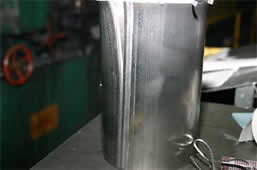 |
| A section of pipe is tested, using both a bend and an expansion test. |
Expanding Horizons, Tightening Standards
As Hastings continues to expand its piping business to countless niches and industrial applications, it hasn’t lost sight of the product that helped build the company’s strong foundation: aluminum irrigation pipe. Despite the influx of PVC pipe used in that industry, Hastings’ customers keep coming back for the quality of product and service they get from Shafer and his colleagues. By incorporating the Dynasty 700 into its tube mills, Hastings has further improved the quality of its product and production rates.
“Our tube is better because of the people that run the mills,” says Shafer. “It’s the people we have working for us. But technology is part of it. This (tube mill) really is an old technology. These mills have been here for years. The people that run them and the type of welding equipment we use helps a lot.”
“Travel speed, consumables and electrodes are going to help us reduce costs,” he adds. “The stability of the arc and our seams are better. There is nothing negative about it (the Dynasty 700). It’s going to help us all the way around.”